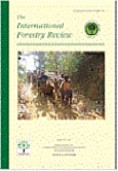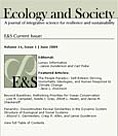Globalisation, logging concessions, conservation organisations and local people
-----------------
A commonly held view in the developed part of the world is that conservation organisations are doing "good" when offering small-scale development activities to improve local livelihoods of people in remote forested areas, such as those in southeast Cameroon. Similarly, logging concessions are often seen as creating conflicts about resource use or environmental degradation while claiming to enhance local development, with little to show in reality. Many remote areas, such as in parts of Central Africa, are also considered somewhat immune to the havoc of our developed world’s financial cycles and crises, yet suffer from the plundering of their natural resources without receiving much in the way of local benefits.
Two recently published papers by teams of scientists from various institutions (Sayer et al. 2012, Lescuyer et al. 2012) paint a somewhat different and more complex picture than this stereotype, presenting a large shade of grey instead of the general black and white view of the relationships between industries, environment and local peoples in tropical forests.
Lescuyer et al. show that improvement of local livelihoods in Cameroon’s forest areas are mostly dependent on macro-economic drivers such as commodity prices, better road infrastructure and new agricultural techniques. Local people are not as forest-dependent as is usually assumed, and logging concessionnaires, whilst not delivering all the promised goods, do not prevent villagers from benefiting from new economic opportunities or from using forest resources, as long as their actions do not affect timber harvesting. Their attitude might best be described as "benevolent" indifference.
In their paper, Sayer et al. demonstrate that foreign direct investment is the key to lifting people in such remote regions out of poverty and, in resisting that investment, conservation organisations may be effectively keeping people in poverty. At the same time, globalisation reaches the poorest of people in the most remote areas and exposes them to the volatility of global markets. For example, when ENRON failed in the USA, a cobalt mine in Lomié, Cameroon, in which it was an investor, closed within months. In the same area, a suspension of logging activities caused by the financial crisis contributed to a deterioration of both biodiversity and livelihood indicators when people lost their jobs and returned to poaching or clearing forests for a living.
Both papers note some negative impacts when forestry activities are not conducted well, but these appear relatively minor compared to the potential beneficial effects of good forestry (for example, when concessions are certified). The contributions to local economies from forestry activities have more impact on the livelihoods of local people than some small eco-development projects promoted by conservation NGOs.
This does not mean these small-scale development activities should be discarded, as they help facilitate dialogue between two very divergent views of nature and the future, and can help build the local empowerment necessary for greater self-determination over future options. But it must also be recognized that the future for both conservation and livelihoods in these remote forest areas will be shaped – at least in part – by properly-designed external investments. Responsible investments and good forestry practice can play significant roles in creating a better future for these people and forests, and shift investors from benevolent indifference to more proactive, locally-oriented development pathways. This will require better collaboration between conservation, industry, state and community actors at the local level, where all have a voice and prior prejudice is left at the door. Both papers note that this will not be easy or quick to achieve, but significant progress can be accomplished with very moderate investment, and some first signs are apparent, such as the increased number of logging companies that are certified and attending more seriously to the needs and aspirations of local communities.
Global financial crisis impacts forest conservation in Cameroon
 The forests of SE Cameroon lie within the Sangha tri-national landscape (TNS), a priority area for biodiversity conservation under the Congo Basin Forest Partnership. A monitoring program showed minimal changes in conservation and local livelihoods indicators from 2006 to 2008. Following the global financial crisis in late 2008 global demand for timber decreased and this led to suspension of logging activities and lay-offs of staff by logging companies; both biodiversity and livelihood indicators deteriorated. The unemployed workers lost their incomes, experienced declining living standards and reverted to poaching and slash and burn agriculture. Pygmies were no longer able to obtain employment in Bantu agricultural plots, sell forest products to logging company employees or sell bushmeat to passing logging trucks. These global economic forces had greater impact on livelihoods and the environment than local interventions by conservation organizations. Livelihood indicators improved in 2010 and 2011 when the economy picked-up but those for environmental values did not recover as rapidly.
The forests of SE Cameroon lie within the Sangha tri-national landscape (TNS), a priority area for biodiversity conservation under the Congo Basin Forest Partnership. A monitoring program showed minimal changes in conservation and local livelihoods indicators from 2006 to 2008. Following the global financial crisis in late 2008 global demand for timber decreased and this led to suspension of logging activities and lay-offs of staff by logging companies; both biodiversity and livelihood indicators deteriorated. The unemployed workers lost their incomes, experienced declining living standards and reverted to poaching and slash and burn agriculture. Pygmies were no longer able to obtain employment in Bantu agricultural plots, sell forest products to logging company employees or sell bushmeat to passing logging trucks. These global economic forces had greater impact on livelihoods and the environment than local interventions by conservation organizations. Livelihood indicators improved in 2010 and 2011 when the economy picked-up but those for environmental values did not recover as rapidly.
Journal Title: International Forestry Review
Volume: 14
Number: 1
Pages: 90-98
Publication Year: 2012
Language: English
ISSN: 1465-5489
DOI: 10.1505/146554812799973172
Logging concessions and local livelihoods in Cameroon
From indifference to Alliance?
 Sustainable forest management gives the opportunity to better integrate the way local populations use their customary “village terroirs” in the logging activities. This requirement is explicitly stated in all forest laws of the Congo Basin countries but its implementation on the field remains under documented. In Cameroon, 30 forest management plans (FMP) for logging concessions have been reviewed to assess how they effectively include customary use rights. The integration of use rights into the FMPs is heterogeneous but always with very low enforcement. The weak influence of the FMP application on local practices is confirmed with an empirical survey that shows that natural, financial, and physical capitals in two villages of the eastern region of Cameroon have been little affected by the adjoining logging concession over the latest 13 years. Extrasector policies such as agriculture, road infrastructure, techniques, and land tenure are the real drivers of socioeconomic change at the local scale. Their impacts are facilitated by the presence of the logging concessions, which can contribute indirectly to improve local livelihoods.
Sustainable forest management gives the opportunity to better integrate the way local populations use their customary “village terroirs” in the logging activities. This requirement is explicitly stated in all forest laws of the Congo Basin countries but its implementation on the field remains under documented. In Cameroon, 30 forest management plans (FMP) for logging concessions have been reviewed to assess how they effectively include customary use rights. The integration of use rights into the FMPs is heterogeneous but always with very low enforcement. The weak influence of the FMP application on local practices is confirmed with an empirical survey that shows that natural, financial, and physical capitals in two villages of the eastern region of Cameroon have been little affected by the adjoining logging concession over the latest 13 years. Extrasector policies such as agriculture, road infrastructure, techniques, and land tenure are the real drivers of socioeconomic change at the local scale. Their impacts are facilitated by the presence of the logging concessions, which can contribute indirectly to improve local livelihoods.
Journal Title: Ecology and Society
Volume: 17
Number: 1
Pages: 7
Publication Year: 2012
Language: English
ISSN: 1708-3087
---------------

